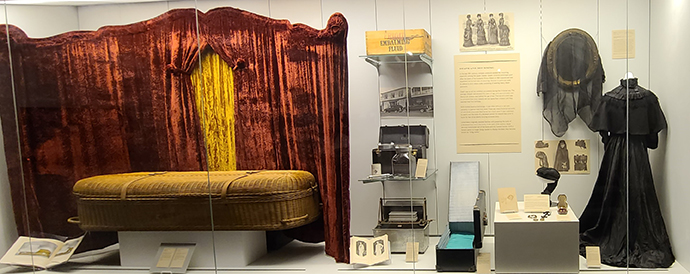The exhibition at Salisbury University’s Nabb Center highlights not only objects we find difficult to discuss, but also provides a peek behind the curtain of museum collections and practices
What do bloodletting tools, a bazooka rocket and a catalog featuring the latest fashion trends for the recently departed have in common? They are all currently on display in the Nabb Research Center’s latest exhibition, Unmentionable: The Indiscreet Stories of Artifacts. Unmentionable examines some of the controversial, intriguing, disturbing and surprising artifacts in the Nabb Center’s collection.
The exhibition highlights not only objects we find difficult to discuss, but also provides a peek behind the curtain of museum collections and practices. Just because an artifact might be considered disturbing or odd by some doesn’t mean it shouldn’t be preserved. In a museum setting, artifacts illustrate a moment in time, a social movement, a person, a place, a scientific development, or an idea. Artifacts stay the same, but their meaning changes based on what is happening around us.
Like many historical repositories, the Nabb Center has been given some unusual and sometimes offensive items over the years. The inspiration behind Unmentionable comes from the ‘curiosities’ that often find their way into museums.

Brooch of Human Hair
During the Victorian era, mourning attire extended to jewelry and other accessories. A popular trend in mourning jewelry was to have elaborately woven bracelets, brooches, necklaces, and earrings made from the human hair of the deceased. This brooch woven of human hair belonged to Mary Rider of Salisbury. Her mother, Josephine A. Toadvine Rider, was born in 1841 and died of “consumption” (tuberculosis) in 1883. Mary, being only nine years old at the time, likely received the brooch to remember and honor her late mother.

Bazooka Anti-Tank Rocket Shell
This bazooka rocket shell was manufactured in Crisfield at the Carvel Hall factory. Carvel Hall was founded in 1895 by Charles D. Briddell. What began as a modest blacksmith shop making carts, farm equipment and crab and oyster harvesting tools, became a thriving business. During World War II, Carvel made machetes and over two million bazooka shells for the war effort. Soon after the war, the company became world famous for its Carvel Hall steak knife. This shell was given to the Nabb Center after the donor found it in the basement of his mother’s home.

Mortuary Collections
Last year, the Nabb Center was contacted by Holloway Funeral Home when they were looking to donate a collection of historic items used by both Holloway and Stewart Funeral Homes in Salisbury. The Center gladly accepted the collection and several items are on display in Unmentionable. From portable embalming jars and tools to sales catalogs featuring the latest in burial fashions, the collection, while perhaps considered macabre, provides a wealth of information about historic mortuary practices.

Women’s Unmentionables
From restrictive garments such as corsets and hoop skirts to sheer slips, women’s undergarments have evolved to complement the silhouettes popular during the day. Changes in undergarments also paralleled women’s changing role in society. Undergarments seem to be abundant in historical collections. The Nabb Center has many wedding trousseaus, which include undergarments. This makes sense as one is more likely to keep items associated with a wedding. Odder are the countless everyday slips, chemises and bloomers that fill collections. We don’t think about donating our used underpants to a museum, but luckily someone did!
To learn more about some of the strange and unusual artifacts at the Nabb Center, visit the exhibit in person or online. Unmentionable: The Indiscreet Stories of Artifacts will be on display through June 5, 2022, in the Nabb Center’s Thompson Gallery (Salisbury University’s Guerreri Academic Commons 4th Floor). You can also explore the exhibit online here.
On Saturday, May 14, 2022, at 1:00 p.m., join Curator of Exhibitions and Engagement, Melinda McPeek, for a behind-the-scenes tour of the exhibition and the Nabb Center facility, including
the state-of-the-art storage rooms. This is a rare opportunity for participants to see artifacts in the collection that are not on view to the public. Registration for the tour is required as space is
limited for this event.
To register, contact the Nabb Center at 410-543-6312 or nabbcenter@salisbury.edu. CS
